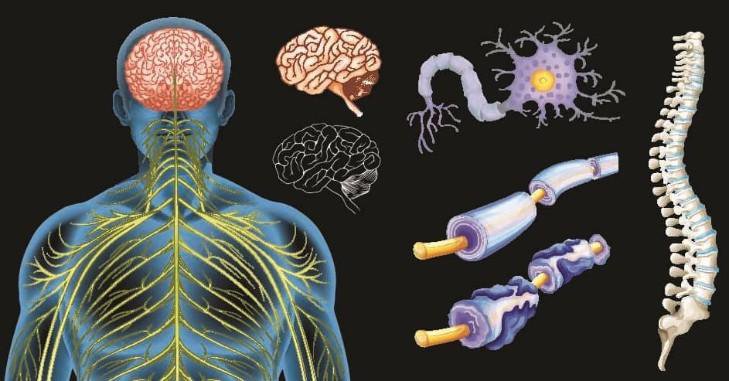Tests to diagnose multiple sclerosis
Multiple sclerosis (MS) is a health problem that can affect the brain and spinal cord, causing a range of potential symptoms. It is one of the most common causes of disability in young people. MS is usually diagnosed in people in their 20s and 30s, although it can develop at any age. The disease is 2 to 3 times more common in women than in men. So what tests can diagnose multiple sclerosis?
1. What is multiple sclerosis?
Multiple sclerosis (multiple sclerosis) is a chronic disease that affects the central nervous system, especially the brain, spinal cord, and optic nerves. This can affect a wide range of organs and organ systems throughout the body.
The progression of multiple sclerosis cannot be predicted in any patient. Some people have mild symptoms, such as blurred vision, numbness, and tingling in the extremities. While others have more severe symptoms such as paralysis, vision loss, and mobility-related problems. However, these cases are relatively rare. Statistics on the incidence of multiple sclerosis are also not really accurate. According to a report by the American Institute of Neurology and Stroke, in the US currently, there are about 250,000-350,000 people with multiple sclerosis, while this number is reported by the Multiple Sclerosis Association is nearly one million people.
The cause of multiple sclerosis is also unknown, but scientists believe it is an autoimmune disorder that affects the central nervous system. When a person has an autoimmune disease, the body's immune system attacks healthy cells and tissues the same way they do with bacteria or viruses. In multiple sclerosis, the immune system confuses the myelin sheaths that protect nerve cells with foreign antigens, so they attack these myelin sheaths, causing indirect damage to the neurons. When the myelin sheaths disappear, they leave scars that lead to sclerosis. Damage to the myelin sheath mainly occurs in:
Brain stem Cerebellum, motor and balance areas Spinal cord Optic nerves White matter in some areas of the brain As lesions develop in more than one area In different areas, nerve fibers can be severed or damaged. Therefore, nerve impulses from the brain cannot be transmitted to the target nerves, making it impossible for the body to perform certain functions.
The progression of multiple sclerosis cannot be predicted in any patient. Some people have mild symptoms, such as blurred vision, numbness, and tingling in the extremities. While others have more severe symptoms such as paralysis, vision loss, and mobility-related problems. However, these cases are relatively rare. Statistics on the incidence of multiple sclerosis are also not really accurate. According to a report by the American Institute of Neurology and Stroke, in the US currently, there are about 250,000-350,000 people with multiple sclerosis, while this number is reported by the Multiple Sclerosis Association is nearly one million people.
The cause of multiple sclerosis is also unknown, but scientists believe it is an autoimmune disorder that affects the central nervous system. When a person has an autoimmune disease, the body's immune system attacks healthy cells and tissues the same way they do with bacteria or viruses. In multiple sclerosis, the immune system confuses the myelin sheaths that protect nerve cells with foreign antigens, so they attack these myelin sheaths, causing indirect damage to the neurons. When the myelin sheaths disappear, they leave scars that lead to sclerosis. Damage to the myelin sheath mainly occurs in:
Brain stem Cerebellum, motor and balance areas Spinal cord Optic nerves White matter in some areas of the brain As lesions develop in more than one area In different areas, nerve fibers can be severed or damaged. Therefore, nerve impulses from the brain cannot be transmitted to the target nerves, making it impossible for the body to perform certain functions.

Bệnh đa xơ cứng (xơ cứng rải rác) là một bệnh lý mạn tính ảnh hưởng đến hệ thống thần kinh trung ương, đặc biệt là não, tủy sống và các dây thần kinh thị giác
2. Classification of Multiple Sclerosis
According to the clinical literature, multiple sclerosis is divided into the following four categories:
Clinically isolated syndrome (CIS): This is the first syndrome with symptoms lasting for at least 24 hours. Recurrent multiple sclerosis: This is the most common form, affecting up to 85% of people with multiple sclerosis. Relapsing multiple sclerosis is associated with a new and progressive onset of disease symptoms followed by partial or complete disappearance. Primary progressive multiple sclerosis: Symptoms worsen gradually and show no signs of remission. Some people may experience short periods of stability. Primary progressive multiple sclerosis occurs in 15% of MS cases. Secondary progressive multiple sclerosis: At first, people will experience intermittent episodes of relapses and remissions but then the disease begins to enter a steady progression.
Clinically isolated syndrome (CIS): This is the first syndrome with symptoms lasting for at least 24 hours. Recurrent multiple sclerosis: This is the most common form, affecting up to 85% of people with multiple sclerosis. Relapsing multiple sclerosis is associated with a new and progressive onset of disease symptoms followed by partial or complete disappearance. Primary progressive multiple sclerosis: Symptoms worsen gradually and show no signs of remission. Some people may experience short periods of stability. Primary progressive multiple sclerosis occurs in 15% of MS cases. Secondary progressive multiple sclerosis: At first, people will experience intermittent episodes of relapses and remissions but then the disease begins to enter a steady progression.

Đa xơ cứng gồm 4 loại: Hội chứng cô lập lâm sàng, Đa xơ cứng tái phát. Đa xơ cứng tiến triển chính và Đa xơ cứng tiến triển thứ phát
3. Symptoms of Multiple Sclerosis
Because multiple sclerosis affects the central nervous system that controls all of the body's activities, symptoms of multiple sclerosis can occur in any part of the body.
The most common symptoms of multiple sclerosis are:
Muscle weakness : Motor nerve damage can lead to muscle weakness. Numbness and tingling: Numbness and tingling is one of the earliest symptoms of multiple sclerosis. They can appear on the face, back, chest, or extremities. Bladder problems: Loss of bladder control is also an early sign of multiple sclerosis. Patients may experience bladder pain, increased urination, or urinary incontinence. Bowel problems: Some people with MS may experience bowel incontinence moving and feeling tired all the time. Dizziness: Dizziness is also a common symptom of multiple sclerosis. Decreased sex drive Muscle spasticity: Also known as motor paralysis, this is an early sign of multiple sclerosis. Damaged nerve fibers in the spinal cord and brain can cause painful and tight muscles, especially in the legs. Vision problems: Some people may experience reduced or complete loss of vision due to inflammation of the optic nerve. Depression: Damage to the central nervous system can cause emotional changes, including depression. Memory loss or memory loss Pain: Pain is a common symptom in people with multiple sclerosis. Nerve pain is a direct symptom. Other cases of pain mainly occur from muscle weakness or stiffness. In addition, some other less common symptoms of multiple sclerosis include: headache, hearing loss, itching, breathing problems, seizures, language disorders....
In the early stages Later, changes in perception, thinking, and sensitivity to heat may occur. Multiple sclerosis affects individuals differently. For some people, MS symptoms are not obvious at first and there is little improvement for months or even years. For others, however, symptoms progress rapidly over several weeks or months.
The most common symptoms of multiple sclerosis are:
Muscle weakness : Motor nerve damage can lead to muscle weakness. Numbness and tingling: Numbness and tingling is one of the earliest symptoms of multiple sclerosis. They can appear on the face, back, chest, or extremities. Bladder problems: Loss of bladder control is also an early sign of multiple sclerosis. Patients may experience bladder pain, increased urination, or urinary incontinence. Bowel problems: Some people with MS may experience bowel incontinence moving and feeling tired all the time. Dizziness: Dizziness is also a common symptom of multiple sclerosis. Decreased sex drive Muscle spasticity: Also known as motor paralysis, this is an early sign of multiple sclerosis. Damaged nerve fibers in the spinal cord and brain can cause painful and tight muscles, especially in the legs. Vision problems: Some people may experience reduced or complete loss of vision due to inflammation of the optic nerve. Depression: Damage to the central nervous system can cause emotional changes, including depression. Memory loss or memory loss Pain: Pain is a common symptom in people with multiple sclerosis. Nerve pain is a direct symptom. Other cases of pain mainly occur from muscle weakness or stiffness. In addition, some other less common symptoms of multiple sclerosis include: headache, hearing loss, itching, breathing problems, seizures, language disorders....
In the early stages Later, changes in perception, thinking, and sensitivity to heat may occur. Multiple sclerosis affects individuals differently. For some people, MS symptoms are not obvious at first and there is little improvement for months or even years. For others, however, symptoms progress rapidly over several weeks or months.

Yếu cơ, tê, ngứa ran là những dấu hiệu dễ nhận thấy của bệnh đa xơ cứng
4. Causes and risk factors of multiple sclerosis
As mentioned above, the cause of multiple sclerosis is not clearly known, however there are a number of factors that increase the risk of the disease including:
Age: Most people with MS have multiple sclerosis. confirmed between the ages of 20 and 40. Gender: The risk of multiple sclerosis in women is twice as high as in men. Genetic factors: People who have a family member with multiple sclerosis have a higher risk of developing the disease than the general population Smoking: People who smoke are more likely to develop MS. They also often suffer more brain damage and shrinkage than non-smokers. Infections: Certain viruses like Epstein-Barr or mononucleosis can increase the risk of multiple sclerosis. Vitamin D deficiency: Multiple sclerosis tends to be more common in people with less exposure to sunlight. Some experts think that low levels of vitamin D affect the functioning of the immune system and lead to multiple sclerosis.
Age: Most people with MS have multiple sclerosis. confirmed between the ages of 20 and 40. Gender: The risk of multiple sclerosis in women is twice as high as in men. Genetic factors: People who have a family member with multiple sclerosis have a higher risk of developing the disease than the general population Smoking: People who smoke are more likely to develop MS. They also often suffer more brain damage and shrinkage than non-smokers. Infections: Certain viruses like Epstein-Barr or mononucleosis can increase the risk of multiple sclerosis. Vitamin D deficiency: Multiple sclerosis tends to be more common in people with less exposure to sunlight. Some experts think that low levels of vitamin D affect the functioning of the immune system and lead to multiple sclerosis.
5. Tests to diagnose multiple sclerosis

Phương pháp chẩn đoán hình ảnh chụp cộng hưởng từ cho phép các bác sĩ đánh giá rõ hơn tình trạng não bộ của bệnh nhân
The diagnosis of multiple sclerosis is relatively difficult. There is no specific test that proves a person has multiple sclerosis. And there are plenty of other health problems that can present symptoms like multiple sclerosis.
Some tests that may be ordered by doctors to diagnose multiple sclerosis include:
Magnetic resonance imaging : Magnetic resonance imaging allows doctors to better assess the condition. the patient's brain. They can see changes caused by multiple sclerosis such as inflammation in the back of the brain or spinal cord. Elderly people, people with high blood pressure or diabetes can also have MRI images similar to people with multiple sclerosis. Therefore, doctors will consider other information before making a diagnosis. In addition, the results of magnetic resonance imaging also did not prove that the patient did not have multiple sclerosis because the damaged areas were not scanned. Lumbar puncture: This method is used to determine the amount of protein and other substances that are markers of disease. Lumbar puncture can be used to aid in the diagnosis of multiple sclerosis, but they do not provide absolute accuracy. EEG: This neurological test helps doctors confirm which part of the brain is affected by multiple sclerosis through brain responses. Blood tests: Blood tests can be used to diagnose multiple sclerosis, but often doctors use them to look for certain substances in a person's blood. The most important thing about a blood test is to rule out other causes of MS-like symptoms. Multiple sclerosis is a serious health condition that affects the nervous system. The progression of multiple sclerosis varies from person to person so it is difficult to predict what will happen to a person, but most MS does not leave serious disabilities. In recent years, scientists have made rapid progress in developing new drugs and treatments for multiple sclerosis. New drugs are safer and more effective, and they offer hope to patients in slowing the progression of multiple sclerosis.
Autologous hematopoietic stem cell infusion can alleviate autoimmune reactions and long-term relapses of the disease. At Vinmec International General Hospital, patients with multiple sclerosis have been treated with autologous hematopoietic stem cell transplantation. Transfusion of autologous hematopoietic stem cells is an attempt to "reboot" the immune system, whose job it is to destroy damage to the brain and spinal cord in multiple sclerosis. For autologous stem cell infusion for multiple sclerosis, hematopoietic stem cells are taken from your body (autologous infusion) from your bone marrow or blood, selected and stored before being depleted. the immune system to the full extent of the chemical. The stored hematopoietic stem cells are then passed back to the body. The new stem cells travel down to the bone marrow and over time restore the immune system.
Some tests that may be ordered by doctors to diagnose multiple sclerosis include:
Magnetic resonance imaging : Magnetic resonance imaging allows doctors to better assess the condition. the patient's brain. They can see changes caused by multiple sclerosis such as inflammation in the back of the brain or spinal cord. Elderly people, people with high blood pressure or diabetes can also have MRI images similar to people with multiple sclerosis. Therefore, doctors will consider other information before making a diagnosis. In addition, the results of magnetic resonance imaging also did not prove that the patient did not have multiple sclerosis because the damaged areas were not scanned. Lumbar puncture: This method is used to determine the amount of protein and other substances that are markers of disease. Lumbar puncture can be used to aid in the diagnosis of multiple sclerosis, but they do not provide absolute accuracy. EEG: This neurological test helps doctors confirm which part of the brain is affected by multiple sclerosis through brain responses. Blood tests: Blood tests can be used to diagnose multiple sclerosis, but often doctors use them to look for certain substances in a person's blood. The most important thing about a blood test is to rule out other causes of MS-like symptoms. Multiple sclerosis is a serious health condition that affects the nervous system. The progression of multiple sclerosis varies from person to person so it is difficult to predict what will happen to a person, but most MS does not leave serious disabilities. In recent years, scientists have made rapid progress in developing new drugs and treatments for multiple sclerosis. New drugs are safer and more effective, and they offer hope to patients in slowing the progression of multiple sclerosis.
Autologous hematopoietic stem cell infusion can alleviate autoimmune reactions and long-term relapses of the disease. At Vinmec International General Hospital, patients with multiple sclerosis have been treated with autologous hematopoietic stem cell transplantation. Transfusion of autologous hematopoietic stem cells is an attempt to "reboot" the immune system, whose job it is to destroy damage to the brain and spinal cord in multiple sclerosis. For autologous stem cell infusion for multiple sclerosis, hematopoietic stem cells are taken from your body (autologous infusion) from your bone marrow or blood, selected and stored before being depleted. the immune system to the full extent of the chemical. The stored hematopoietic stem cells are then passed back to the body. The new stem cells travel down to the bone marrow and over time restore the immune system.
Để đặt lịch khám tại viện, Quý khách vui lòng bấm số HOTLINE hoặc đặt lịch trực tiếp TẠI ĐÂY. Tải và đặt lịch khám tự động trên ứng dụng MyVinmec để quản lý, theo dõi lịch và đặt hẹn mọi lúc mọi nơi ngay trên ứng dụng.
References: medicalnewstoday.com, webmd.com
SEE MORE
Multiple sclerosis: What is multiple sclerosis (or multiple sclerosis)? Treatment of systemic scleroderma
SEE MORE
Multiple sclerosis: What is multiple sclerosis (or multiple sclerosis)? Treatment of systemic scleroderma






